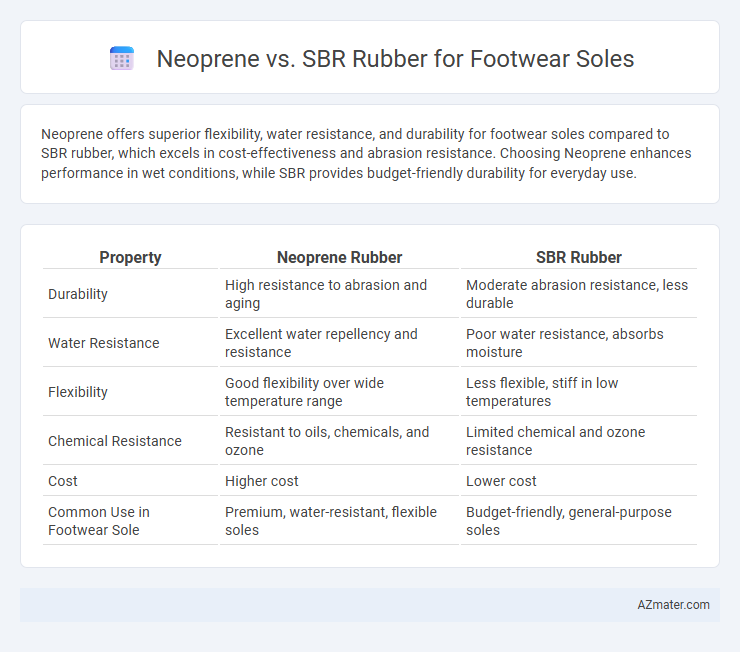Neoprene offers superior flexibility, water resistance, and durability for footwear soles compared to SBR rubber, which excels in cost-effectiveness and abrasion resistance. Choosing Neoprene enhances performance in wet conditions, while SBR provides budget-friendly durability for everyday use.
Table of Comparison
| Property | Neoprene Rubber | SBR Rubber |
|---|---|---|
| Durability | High resistance to abrasion and aging | Moderate abrasion resistance, less durable |
| Water Resistance | Excellent water repellency and resistance | Poor water resistance, absorbs moisture |
| Flexibility | Good flexibility over wide temperature range | Less flexible, stiff in low temperatures |
| Chemical Resistance | Resistant to oils, chemicals, and ozone | Limited chemical and ozone resistance |
| Cost | Higher cost | Lower cost |
| Common Use in Footwear Sole | Premium, water-resistant, flexible soles | Budget-friendly, general-purpose soles |
Introduction to Neoprene and SBR Rubber
Neoprene is a synthetic rubber known for its excellent flexibility, chemical resistance, and durability, making it a popular choice for high-performance footwear soles. SBR (Styrene-Butadiene Rubber) offers strong abrasion resistance and cost-effectiveness, widely used in shoe manufacturing for its robust wear properties. Both materials provide essential benefits, with neoprene excelling in comfort and resilience, while SBR is favored for toughness and affordability in footwear applications.
Chemical Composition and Structure
Neoprene is a synthetic rubber derived from chloroprene monomers, featuring a polychloroprene polymer chain with excellent resistance to oils, chemicals, and weathering, making it highly durable for footwear soles. SBR (Styrene-Butadiene Rubber) consists of styrene and butadiene copolymers with a random structure, providing good abrasion resistance and flexibility but lower chemical stability compared to neoprene. The chlorinated backbone in neoprene imparts greater resilience and environmental resistance, whereas SBR's unsaturated hydrocarbon chain results in higher susceptibility to ozone and aging.
Durability and Abrasion Resistance
Neoprene exhibits superior durability and abrasion resistance compared to SBR rubber, making it ideal for high-performance footwear soles that endure intense wear and tear. Its synthetic chloroprene composition provides enhanced resilience against environmental factors, including oils, heat, and ozone, which commonly degrade footwear materials. SBR rubber, while less expensive and offering good abrasion resistance, generally wears down faster under prolonged mechanical stress and exposure, reducing its lifespan in demanding applications.
Flexibility and Comfort in Footwear Soles
Neoprene offers superior flexibility and cushioning, making it ideal for footwear soles that require enhanced comfort and durability under dynamic movements. SBR rubber provides good abrasion resistance but tends to be stiffer, resulting in less flexibility and reduced comfort during extended wear. Footwear soles incorporating neoprene significantly improve shock absorption and adaptability to foot contours compared to traditional SBR rubber soles.
Water and Weather Resistance
Neoprene offers superior water resistance and excellent weather durability, making it ideal for footwear soles exposed to wet and harsh environments. SBR rubber provides moderate water resistance but tends to degrade faster under ultraviolet exposure and extreme weather conditions. Choosing Neoprene enhances long-term performance and protection against moisture and temperature fluctuations in footwear applications.
Slip Resistance and Traction Performance
Neoprene offers superior slip resistance and traction performance for footwear soles due to its excellent flexibility and resistance to oil, water, and weathering, making it ideal for wet and slippery conditions. SBR rubber provides decent slip resistance but tends to harden over time, reducing its grip and traction on various surfaces. Choosing neoprene enhances durability and safety in demanding environments where slip resistance is critical.
Thermal Insulation Properties
Neoprene offers superior thermal insulation properties compared to SBR rubber, making it ideal for footwear soles designed to retain heat in cold environments. Its closed-cell structure effectively reduces heat transfer and provides better resistance to freezing temperatures. SBR rubber, while durable and cost-effective, has lower thermal insulation capabilities and tends to conduct heat more rapidly, which can lead to less comfort in cold conditions.
Cost Comparison: Neoprene vs SBR
Neoprene typically costs more than SBR rubber due to its superior durability, flexibility, and resistance to oil and weathering, making it a premium choice for footwear soles. SBR rubber is more budget-friendly, favored for its cost-effectiveness and adequate wear resistance in casual footwear applications. The price difference influences manufacturers' decisions, balancing performance requirements with production budget constraints.
Environmental Impact and Sustainability
Neoprene, a synthetic rubber derived from petrochemicals, is less environmentally friendly due to its non-biodegradable nature and high energy-intensive production processes, contributing to greater carbon emissions and landfill waste. SBR (Styrene-Butadiene Rubber), widely used in footwear soles, also relies on petroleum but has slightly better recycling options and partial bio-based alternatives emerging, reducing its overall environmental footprint. Both materials pose challenges for sustainability, yet advancements in bio-based SBR and improved recycling technologies aim to minimize their ecological impact in the footwear industry.
Best Applications for Each Material in Footwear Soles
Neoprene rubber excels in footwear soles designed for water resistance, flexibility, and insulation, making it ideal for wetsuit boots and water sports shoes. SBR rubber offers superior abrasion resistance and cost-effectiveness, making it suitable for casual and everyday footwear requiring durability and wear resistance. Choosing neoprene supports enhanced comfort in wet environments, while SBR provides a budget-friendly option for rugged, long-lasting soles.

Infographic: Neoprene vs SBR rubber for Footwear sole
 azmater.com
azmater.com